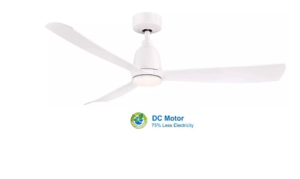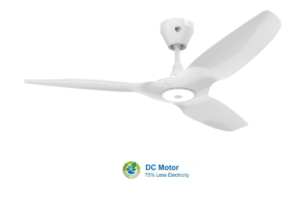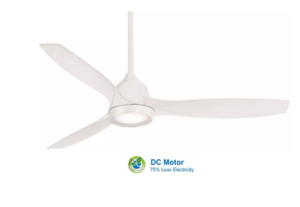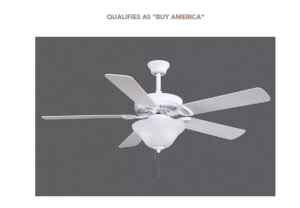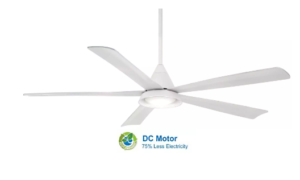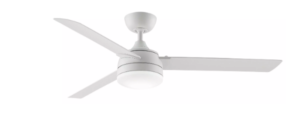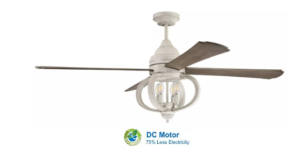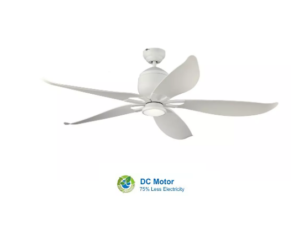There are thousands of ceiling fans out there on the market. But for this article, we focused on our favorite ceiling fans with a white blade finish. White ceiling fans can generally be found in kitchens, outdoor areas, and other rooms of the house. It really all depends on your individual home and what you are going for.
If you want to learn everything there is to know about buying a ceiling fan, you are in the right place. Scroll to the bottom to read our extensive guide on all things white ceiling fans.
The Fanimation Kute is available in a 52” or 44” blade span with multiple finish options to match your room decor. The ceiling fan includes a handheld remote control and is damp rated so it will be a great addition to your outdoor space. Just remember that damp means it still can’t be exposed to direct rain. You can turn it into a smart device with a Fansync WiFi receiver sold separately. It can connect to your home automation system and operate in unison with other elements. It can be controlled by Google and Alexa Voice commands.
You also get a hand held remote that comes with a varied speed control, fresh air, home away and a safe exit function. As this is an energy-star qualified fan, you can run multiple fans without hurting your energy bill. The DC motor consumes only 36 watts per hour.
The Fanimation fans are made to perform at their best year after year. The Kute series is one of the most advanced models from Fanimation you can get for your home. It gives an ease of control and proves to be a great addition to your indoor and outdoor decor.
The Haiku L series comes with an optional Wi-Fi module that can utilize voice commands. It is compatible with Google Assistant and Amazon Alexa so you can control the lights and fans from anywhere. Unlike most other brands, the Haiku remote control can operate two fans at a time even from a distance of 30 feet.
The fan includes a “Whoosh Mode” that will vary the wind speed to feel more like a breeze. With a wind speed factor of 3.24 MPH expect a strong cooling breeze under its blades. The Haiku L series also has optional high- tech components like home automation technology. Moreover, it comes with an integrated dimmable LED light kit.
The Haiku series is known for its hi-tech features to complement your smart house. The Haiku L series retains the company’s legacy while continuing to keep customers happy with its advanced features at a nominal market price.
The Minka Aire Skyhawk has a stylish design bearing real solid wood blades. Unlike plastic blades, they add more warmth and value to your interiors. The curved blade design produces exceptional breeze at a wind speed factor of 3.28 MPH. The super efficient DC motor saves more energy than an average AC fan, plus it is durable.
The fan comes with an integrated dimmable LED light that glows at 1649 lumens and 3000k color temperature. The illuminance is very purposeful for reading or writing as well. The LED is rated for 30,000 hours which means it will last 30 times longer than a typical incandescent bulb.
Minka always designs multi-purpose fans. The Skyhawk series is suitable for both lighting and cooling purposes. The fans are good looking and can perform against any other high ranking fans in the similar range.
The America USA 52” Fan comes with reversible light/white oak blades coupled with a single bowl LED light kit (optional). The model includes a bottom cap for installation with or without the light fixture. The fan is completely meant for small rooms and indoor applications only.
The efficiency rating is 79 CFM/Watt which is just below the average figure of 86 CFM/Watt. So, it is not an energy-efficient option to run multiple fans at the same time. The wind speed factor is 2.69 MPH to provide a moderate cooling breeze. The airflow is also average with 4643 CFM so only expect to experience air around its immediate vicinity.
The America USA Fan from the Matthews Fan Company qualifies for the BAA (Buy American Act). So, unlike other China-made models, it is purely made-in-USA product. As it runs on a DC motor, it consumes less electricity (65 watts per hour) than the average figure (76 Watts per hour).
The Minka Aire Cone is a high performance LED ceiling fan rated for wet locations. This fan comes with 3, 4 or 5 blade options to let you configure a design as per your convenience. The fan features a dimmable LED light that can be controlled with a 6 speed hand held remote control.
The fan features a DC motor that makes it extremely energy efficient. With a wind speed rating of 4.53 MPH, it offers the strongest breeze in the market. This fan is perfect for your porticos, balconies and outdoor sitting areas. It is also easy to clean with a hose.
The Minka Aire produces some of the best rated outdoor fans in the country. The Cone series is especially crafted to provide both adequate light and cooling in outdoor areas. You can even directly expose it to wind, snow and rain which makes it highly weather-resilient.
Modern Forms TipTop Flush mount is a smart fan and Wi-Fi enabled. It is compatible with Google Assistant, Amazon Alexa, Nest, Samsung Smart Things and Ecobee. It also includes a full function Bluetooth hand-held remote control with a full range light dimmer. For those who don’t need smart features, it also includes a wall control with same functionalities.
The fan comes with a 3000k LED Light that is closest to the natural white fixture. You can also opt for 2700k LED (softer yellow color) or a 3500k LED (crisp blue color) variants to create that perfect ambiance. It has an EnergyStar qualified DC motor to save you more energy than conventional AC motors.
Modern Forms fans are fit for a house of any decor. With the Tip Top series, Modern Forms is adding smart voice controlled fans to its existing elite products. They run quietly and smoothly so that your sleep remains uninterrupted.
The Fanimation Xeno Wet is one of the best rated outdoor ceiling fans with a stunning LED Light fixture and EnergyStar qualified AC motor. The contemporary designed body is anti-corrosive and rust-resistant to meet your outdoor requirements. The fan features a 14 degree blade pitch that produces a 5-star airflow to blow your socks off. If you are looking for a powerful, white, outdoor ceiling fan – this is it.
The 188 x 25 mm AC motor saves energy and runs very smooth and quiet. The Dimmable LED light fixture is available with an opal frosted glass. The light aids decoration and provides 1440 Lumens equivalent to a 75W incandescent light. The fixture utilizes 18 watt LED Array that consumes minimal energy but produces excellent brightness.
The Fanimation ceiling fans are popular for featuring Energy Star qualified motors to save energy under any circumstance. In this regard, the Xeno series is exceptionally good for your outdoor spaces. It’s made to withstand the trials of weather and would last for years.
The Monte Carlo Turbine ceiling fan comes with ABS white rubberized blades to perform under tough environments. The 6-degree blade pitch throws wind at 4.16 MPH which is just above average. But, you will get a strong breeze of 8334 CFM airflow, enough to take over every corner of your room.
It has a dimmable uplight and downlight to be controlled from a 6-speed remote control. The DC Motor inside runs at an efficiency of 272 CFM/Watt where the average is just about 86. So expect terrific efficiency at a low energy cost.
The Monte Carlo fans showcase maximum performance than others in the similar price range. Indeed, it’s an ideal purchase for any type of home.
The Craftmade Augusta 60inch ceiling fan flaunts Driftwood finished solid wood blades. It is ideal for large rooms or places where you need a maximum airflow. The integrated LED light kit consists of a light fixture and four LED bulbs (4W each) to offer maximum illumination.
The super efficient DC motor saves up to 75% more energy than AC fans. Also, it attributes to the fan’s smooth running and quiet functioning. You get dual control options of a hand held remote and a wall control. It has a full range light dimmer and 6-speed forward/reverse controls.
Craftmade produces durable fans to meet modern home decors. This series is your perfect pick for large visiting areas whether home or office. The energy saving functions allow you to operate multiple fans at the same time without tripping up energy cost.
With rubberized white blades, the Monte Carlo Lily ceiling fan appeals to modern aesthetics. Its u-shaped blade irons and their upward curves cleverly utilize the extra space towards the ceiling to uplift the room décor. With 14 degree blade pitch, it distributes air evenly. This contemporary fan is UL rated for both indoor and outdoor purposes.
The integrated LED fixture engulfed in a clear frosted glass diffuser gives a soft focus. With a 12W LED array, it adds ethereal ambiance to the entire room. The hand-held remote can control light, speed and rotation (forward/reverse). As it runs through a DC Motor, rest assured of an energy-saving performance each time.
Monte Carlo fans are popular for offering more than promised. The designs are almost whimsical just like the Monte Carlo Lily. Additionally, the lifetime motor warranty gives one more reason to consider these fans over the others in the first place.
As an affiliate partner, we may earn from qualifying purchases made on these products.
A Ceiling Fan Buyer’s Guide: Everything To Know When Buying a White Ceiling Fan.
We have a deep love for ceiling fans and live to help others understand these products as well as we do. That is why we took the time to write a ceiling fan buyers’ guide.
Buying a white ceiling fan for the first time can be overwhelming. There are many options for fans and each fan has different styles, sizes, functionality, blades, and installation steps.
Also, there are different shades of white coloring, ranging from ghost white, white smoke, baby powder, Snow, and Ivory whte
We will walk you through how to think about each color.
Fortunately for you, we have distilled all of the key variables down into an accessible and digestible guide. You can read this guide if you want an in-depth understanding of ceiling fans or you can skim it if you only want to better understand certain aspects of the fan itself.
This includes how to select a white fan to buy, the types and angles of a fan’s blades, the pros and cons of the AC and DC motors that power fans, and how to install the fan on your ceiling. If you follow this guide you can be confident that you are making a well informed buying decision.
We know all things ceiling fans and want to pass on our learnings and insights to help you.
Most importantly, we know that once you evaluate, select, and install a white ceiling fan it will likely remain in place for many years to come. That is because ceiling fans can be heavy, expensive, and labor intensive to install.
A central air conditioning system consumes 3 kiloWatts, which is about 36 cents per hour. Running a fan only runs at 30 Watts, equivalent to only a cent per hour.
This makes fans affordable and energy efficient alternatives that many people love as they are good for you, your wallet, and the environment.
Running a fan that turns off when a certain temperature range is reached is even more affordable.
Take the time to do research now before buying because the switching costs of changing your mind can be high.
Go through this evaluation check-list so that you better understand the types of motors, blades, installation units, and fans that exist. We encourage you to optimize for:
- Overall quality: in particular the speed of the motor to optimize for cooling efficacy and quietness.
- Aesthetics: in particular ensure that you are happy with how the fan looks, its shade of white coloring, shape, design, and blade count.
- Size: select the right size fan for the room you will be placing it in. Larger rooms require larger fans to create strong air flow.
Selecting the location of a ceiling fan: Inside or Outside
Most white ceiling fans are used within the home. Others are for outdoor structures. Before deciding which type of white ceiling fan to buy, determine where you will place it. Understanding the placement of a ceiling fan will help you select other attributes – like size, speed, and sound – that will enhance your experience with the fan.
Outdoor fans require different electrical strategies and water-proof finishes. Please keep this mind throughout the guide as we largely focus our attention and advice to those people who want to install indoor fans.
If placing the white ceiling fan in an indoor room, measure the size of the room.
Bathrooms tend to be smaller than bedrooms which tend to be smaller than living rooms or kitchens.
Knowing the approximate size of the room in which the fan will be placed is important.
Larger fans are best suited to larger rooms as their blades and motors move greater volumes of air.
Ceiling Fan Size Chart
| Room (in feet) | Cubic Feet/Minute | Fan Size |
| 6′ x 6′ | 3,000 – 4,500 | Shop: 24″ to 36″ |
| 10′ x 10′ | 4,000 – 5,500 | Shop: 37″ to 48″ |
| 12′ x 12′ | 6,200 – 7,500 | Shop: 49″ to 56″ |
| 15′ x 15′ | 7,000 – 9,000 | Shop: 60″ to 72″ |
| Larger | 9,000 – 11,000 | Shop: 80″ to 99″ |
The length of the blade of the fan and the size of the room go hand in hand.
In short, if you have a large room, buy a larger fan. The bigger the fan the better.
The common sizes for ceiling fans are 36, 44 and 52 inches, with the large fans having a blade wingspan of 60 inches.
Of course you can technically go even larger, with the largest recreational home fans having up to 99 inches of wingspan.
99 inches is 8.25 feet. That is a large fan indeed.
Measure the height of the ceiling and allow at least 7 feet and 6 inches of space.
It is wise and safe to place your fan at least 7 feet above your flooring.
Placing a white ceiling fan high up protects tall individuals from hitting their head or having their hair caught while the fan is in motion. Fans need to be installed on ceilings and these installation bases take space as well.
An installation base is adjoined to a downrod, which is a simple piece of metal that the fan is connected to and hangs from.
The average American ceiling height today is 9 feet (2.7432 meters). This means that the average room can support a fan but with a shorter downrod.
If you have average sized ceilings you can afford to install no more than 1 foot and 6 inch downrods.
How to measure downrods and base mounts
A ceiling fan is composed of fan blades, a downrod, and an installation base.
The installation base attaches to the ceiling. The downrod connects to the base. And the fan itself hangs from the downrod.
Per the measurements mentioned above, the fan must be at least 7 feet and 6 inches above the ground if you have a standard 9 foot ceiling.
There is one exception: fans placed above beds, where you will not walk, require less height.
Many downrods match the color of the fan. So if you want a back ceiling fan you will likely want a complimentary white downrod to go with it.
Many people enjoy selecting the fit and finish of the downrod as these pieces of metal or plastic come in different colors, shapes, and sizes and compliment the overall fan’s aesthetic.
As a general rule, more expensive ceiling fans enable you to have longer and more customizable downrods. The downdrods tend to be longer – between 6 and 18 inches.
This is for functionality and aesthetics. Cheaper ceiling fans sometimes have very short – or almost nonexistent downrods – because the base and the fan are fused together.
Design and Look: what a white ceiling fan looks like
A hugely important aspect of a ceiling fan is what it looks like. If you see the fan while lying in bed or while in your living room you will want it to look great.
The base and downrod are not nearly as important as the blades for how a fan looks in a room.
Blades come in different cuts, lengths, seizes, finishes, colors and of course quantities.
When people think of a white fan, they often think of white blades and a matching flush mounting and downrod.
This is important to clarify: when buying a white fan do you want the entire unit to be white or only a portion? Do you want all white exteriors (blades, motor casing, and downrod) or only white blades?
These are minor but important details to think through. Many people love the idea of having a consistent color scheme.
How many blades should the fan have?
At a minimum, a white ceiling fan will have two blades though four or five are certainly more common.
A two blade fan can be made of one long piece of metal connected at the mid-point or two distinct blades.
Blades add functionality and impact the air flow.
When you look at a fan that is turned on, the blades are hard to see. When the fan is stationary, however, the design and color of the blades will need to align with your preferences for style and decor.
Fans with four to six blades produce a lower pitch, softer volume noise output. Three blade fans use the air surrounding the fan most efficiently and require the least effort to clean as you have fewer blades and surface area to collect dust.
Windmill fans, always popular in kid’s rooms, have the most surface area of blades. This increases the effort to clean and dust these fans.
A popular 12 blade white Windmill Fan with a light.
The shade of white, material, and quantity of the blades impact how the fan looks and performs.
Another subtle variable is at play too: the angles of those blades. If the blades are too flat, they won’t whisk through the air and create air flows. We highly advise blades with angles between 12 and 14 degrees.
Nearly all of the fans we provide you here have angles in that range for optimal air circulation and air flow efficacy.
More than a fan: how a white ceiling fan provides lighting, symmetry, and aesthetic benefits.
Some people buy ceiling fans simply to cool or heat a room. Others buy ceiling fans because they can be elegant and add character to a home. Some fans have lights and others do not.
If you are going to place your fan in the center of a room – for example, your living room – you might do so at the expense of a central lighting system.
For this reason, adding lights to fans is popular. If you add lights you will want to also consider how easy it is to change the bulbs, especially if the fan is very high above your floor.
LED, Halogen, and Fluorescent lighting options are available on all fans that have integrated lighting.
Control Your Environment: Noise and Air Flow
Fans without lights produce two types of energy outputs when they are on: noise and air-flow. Both will impact your experience with the fan. Fans with lights also produce illumination as an energy output.
Firstly, noise is a byproduct of any fan. The rotation of the blades and the motor can cause distinct sounds. Larger motors produce more power and, as a result, can generate more noise.
The good news is that noise can be mitigated.
Motors that are built from higher quality and durable screws, armature, bearings, windings, and rotors are more expensive.
Cheaper fans have motors that usually produce more noise as a byproduct.
If you want a quieter fan, buy a more expensive one. You won’t regret it.
Please pay particular attention to this when considering which type of fan you will place in different rooms in your home. If you are considering a bedroom ceiling fan, it is prudent to optimize for minimal sound.
People tend to care less about noise when a fan is in a garage or bathroom.
The second type of energy output is air-flow.
Fans can not only cool rooms, they can also heat rooms and reduce air moisture.
They substitute central cooling or work in conjunction with air conditioning.
Fans do not lower air temperatures. They produce air flows and circulation which can in turn create the effect of a windchill.
The wind chill temperature is how cold people feel. The air flow, which leads to evaporative cooling (deratification), is generated by the ceiling fan.
If you are using a fan for general room cooling, you will want a fan that accelerates the heat loss from exposed skin.
Put simply, you will want a fan that generates significant air-flows point downwards and towards the center of the room.
Air Flow Deep Dive: Cubic Feet per Minute
Air flow is the volume of air that is produced by the fan.
The most common way to measure air flow is Cubic Feet per Minute (or CFM).
All of the fans we review have a CFM rating so that you can easily compare how much air that each fan produces.
The average CFM is around 5,000.
For nearly all non-industrial use-cases, like your home bedroom, kitchen, living room, or garage, a CFM of 6,000-7,000 is optimal.
At this rate you will be left feeling cooler without greatly enhancing your energy bill or having papers strewn all over the place from the powerful wind currents that larger fans produce.
You might also see a measurement similar to CFM which is air (or wind) Miles Per Hour.
Much like measuring the speed at which one drives, a fan can have its air speed measured too.
Nearly all fans produce between 3 and 5 Mile Per Hour air flows. Naturally, the higher the MPH, the stronger the air flows.
Controlling Your Fan and Your Energy Output for Efficiency
Mobile apps and the internet have changed how we communicate, manage, and control various technologies.
White ceiling fans are no exception.
Ceiling fans are well suited for management by a digital switch, remote, or mobile app because you can power the fans on or off (or even alter the speed) from afar.
A connected fan is controlled via a remote control or smartphone. In contrast, less expensive and simpler fans are controlled via a manual switch.
Lastly, some ceiling fans are controlled by pull chains.
While chains are usually made long enough for all users to reach them, please keep in mind that this can cause discomfort or annoyance on high ceilings or fans that need to be frequently turned on or off. Nearly all white fans have matching white pull chains.
If you plan on installing your fan over 9 feet above the ground, you should buy a fan that can be controlled digitally.
All ceiling fans can create air-flows bi-direactionally.
Usually a simple switch exists on the fan’s motor or external base that enables you to change the direction in which the blades rotate.
Changing the directional air propulsion is critical during the winter months.
Rather than have air convected from the center of the room for cooling, you will want air to move from the blades horizontally down through the walls.
Lateral air-flow is used for heating rooms and maintaining central warmth while reducing your energy bill.
Choosing the right ceiling fan direction
How you control your fan is correlated with how much energy your fan uses. Will you leave it running all the time? Or will you use smart logic to power it down after a certain amount of time?
We have gone above and beyond to think about fans not just as cooling mechanisms but as a tool that can help you save money while lowering your ecological footprint. These efforts will, most importantly, save you money.
Let me explain further.
When you use central cooling or air conditioners, you are physically reducing the temperature in a room.
An air conditioner sucks air into its ducts through a vent. This air cools the gas in the evaporator and as the heat is removed from the air, it is cooled. Cool air then flows into your room.
This process is energy intensive and expensive.
In contrast, a ceiling fan does not cool the room or remove heat. Rather, it moves air around which creates the feeling of cooling. Actual cooling is not occurring. Less energy out means less energy in. And in total this means a lower energy bill.
What A White Ceiling Fan Looks Like To You and Others
This guide provides ample information pertaining to how a ceiling fan works and things you should be aware of before buying one or many fans for your home.
What we have not discussed in great depth is how a fan looks and the importance of design aesthetics.
A fan will need to fit aesthetically into your room and, as a result, you should think about material (wood, metal, plastic), color, and design patterns. Some questions to reflect on:
- Is the room light or dark? Is it naturally well lit or does it require lots of electrical light?
If your ceiling fan is going in the center of your living room, for example, you will likely want a fan with built-in lighting. This is because many living rooms have existing fixture hardware and wiring.
- Do you want a smart fan that connects with your digital applications and services (Google Home, Nest Apple Siri, Amazon Alexa)?
If you control other aspects of your home – like the temperature and humidity – via smart apps, you might want to add a ceiling fan as another connected Internet of Things device. Likewise if you have high ceilings and plan to install a fan that you can’t easily reach by hand.
Smart fans can be controlled via your phone, tablet, or voice, and these controls will make turning them on or off easier.
- Do you want a white windmill fan?
Windmill fans are harder to clean (more blades means more surface area for dust to land and accumulate). On the other hand, windmill fans are quiet and elegant.
This type of fan is also hugely popular in kids rooms and living rooms.
The windmill fans pay homage to an older design aesthetic.
While this fan is not modern chic it goes very well in rooms with wooden floors or darker walls because it is made of simple plastic or wood finishes, glass fiber reinforced polyester, and thin pulp-plastic infused blades.
- What shade of white do you want the fan? What style finish do you want?
Sleek and minimalist fans have fewer blades. These fans, made of lightweight metal, have universal white finishes. Here are popular white finishes that you can check out to see which finish you think looks best:
- Snow Day White
- Navajo White
- White Dove
- Pure White
- White Smoke
- Baby Powder White
- Snow
- Ivory White
White adds sophistication and class to any room. white fans look great and match lighter room color schemes with ample natural light.
Where to buy a white ceiling fan?
Ceiling fans are heavy and can be difficult to fit in a car or to transport yourself unless you have a large vehicle or flat-bed truck. Given this, it makes a lot of sense to have your fan shipped to you so that it arrives ready for home assembly.
You can self-install a ceiling fan. This work requires moderate technical skills and physical strength. This is because you will need to install not only the fan (the blades) but you will need to connect the fan’s base to the ceiling and its electrical fixture hardware and wiring.
How much do ceiling fans cost? What impacts the price of a fan?
White ceiling fans range in price from $100 on the cheap-end to over $1,500 on the high-end. There are several reasons why the range in price is so large.
A ceiling fan, made of plastic instead of more durable wood or metal, is cheaper.
Additionally, less expensive white fans have weaker motors. This means that they are capable of producing less air flow or have smaller Cubic Feet per Minute scores.
More expensive fans are akin to those you would experience at a resort or high end hotel. A ceiling fan over $1,200 will likely come packed with high tech solutions built-in.
These fans will enable you to:
- Program the fan based on motion, temperature, or humidity.
- Turn the fan on or off based on preset logic or rules for maximum physical comfort.
- Enjoy very efficient and quiet DC motors that have multi-decade support and lifetime expectations.
Moreover, these pricer fans come with app based (smart phone, iPad) mobile management and remote controls.
It is common for expensive ceiling fans to come with mount options so that you can install a panel adjacent to your light switch. These wall mounts enable you to control not only the fan (on/off) but also the fan speed and direction.
AC vs DC fans: Understanding a fan’s power source
Cheaper fans do not come with these in depth level of controls or sophisticated management features.
And that is ok. Simplicity might be what you crave.
Cheaper fans cool rooms as well and can be easily turned on/off with pull chains.
Less expensive fans (in the $100-$300 price point) still come with energy-efficient dimmable lightbulbs.
Most inexpensive white fans leverage AC motors.
Although AC motors are more powerful than DC motors, they typically are less efficient and are not as good at using their energy output.
This can cause additional noise (thereby making it harder to sleep if that fan is in your bedroom).
When buying a fan, please take a moment to see the Power Source listed in the fan’s essential product information that all suppliers provide. If you buy a fan with an AC motor, it will be louder.
As a result, we highly advise buying a DC powered fan if you will be sleeping near it.
AC motors are durable and longer lasting. While this might seem positive, DC motors are better (and therefore more costly).
DC motors are simpler to install into the fan’s base, have high startup power, and have a faster response time.
This means that time will be shortened from when you switch the “on” button to when the fan is accelerating to cool your room.
Although more expensive, ceiling fans with DC motors consume 70% less power which will enable you to save money over time as you pay less to power them.
Where to place the ceiling fan: voltage and flush mounting
Many people place their ceiling fans in the center of a room or above a bed. This is to maximize comfort and the impact of the fan’s air flows.
A centrally placed white ceiling fan also creates room symmetry.
Voltage is the pressure from an electrical circuit’s power, and the most common electrical outlet in any home is a 110 volt. If you live in the United States, you will need to select a fan that complies with this voltage limit.
Luckily for you, nearly all off-the-shelf ceiling fans support this standard.
When installing a ceiling fan you will need to get a few things absolutely right. We have done this many times for ourselves, our family, friends, and of course our clients.
Firstly, some ceiling fans support flush mount integrations. Flush mount fans sit directly against the ceiling and point downwards. These fans are typically useful for cooling a small room.
Not all ceiling fans are flush mountable.
This means that they will hang lower from the ceiling. If you buy a fan that cannot be flush mounted, please ensure that the lower point of the fan is at least 7 feet and six inches from the ground.
Additionally, ensure that the weight bearing load of the ceiling can support the fan.
Similar to voltage, this should be routine in many homes.
But it is worth investigating because you don’t want to buy a fan just to see it unable to stay upright.
For most fans that we review and see our clients deploy, a ceiling must be able to support approximately 35 pounds of downward pressure.
Buyer’s Guide Summary: Bringing It All Together
Buying a white ceiling fan for the first time does not need to be overwhelming.
Simply follow this guide to evaluate and buy the fan that fits best in your room and adds the most value in your life.
Don’t get too bogged down in the details. If nothing else, pick a fan that looks great, fits well within your room, and that is priced according to your budget.
Try to select a shade of white that you think will match the room the ceiling fan will be placed in.


